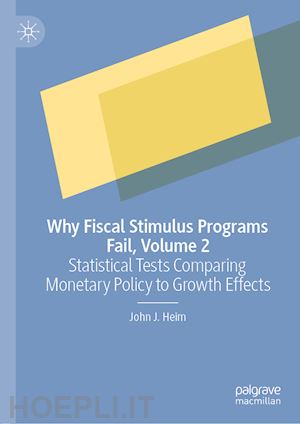
Questo prodotto usufruisce delle SPEDIZIONI GRATIS
selezionando l'opzione Corriere Veloce in fase di ordine.
Pagabile anche con Carta della cultura giovani e del merito, 18App Bonus Cultura e Carta del Docente
Chapter. 1 Introduction.- Chapter 2. Literature Review.- Chapter 3. Methodology.- Chapter 4. Theory of Crowd Out and Accommodative Monetary Policy.- Chapter 5. The Role of Primary Dealers, Investment Banks and Foreign Banks in Federal Reserve Efforts.- Chapter 6. Does Crowd Out Really Occur? Initial Empirical Evidence – One Time Period.- Chapter 7. Does Crowd Out Really Occur? Empirical Evidence – Replication in Many Time Periods.- Chapter 8. Initial Tests of Whether Crowd out Effects Can be Offset by Increases in Loanable Funds.- Chapter 9. Which Models Best Explain How Changes in Loanable Funds Offset Crowd Out?.- Chapter 10. Do Loanable Funds Modify the Crowd Out Effects of the One-Variable Deficit (T-G).- Chapter 11. Do Loanable Funds Modify the Crowd Out Effects of the Two-Variable Deficit (T), (G)?.- Chapter 12. Does M1 or Total Loanable Funds Better Define the Extent to Which Crowd Out Can be Modified?.- Chapter 13. Alternate Ways of Modeling How Deficit Variables Modified by Accommodative Monetary Policy Reduce Crowd Out (Bernanke, Mankiw definitions Of Accommodative Monetary Policy).- Chapter 14. Does Modification of the Single Variable Deficit (T-G) by FR Purchases Better Measure Crowd Out, Controlling for Endogenous Loanable Funds Growth?.- Chapter 15. Does Modification of the Two Variable Deficit (T), (G) by FR Purchases Better Measure Crowd Out, Controlling for Endogenous Loanable Funds Growth?.- Chapter 16. Do FR Purchases, Used as Deficit Modifiers, Reduce Crowd Out, Controlling for the Level of Private Saving and Foreign Borrowing.- Chapter 17. Level of Private Saving and Foreign Borrowing for Private Savings?.- Chapter 18. Do FR Purchases Reduce Crowd Out Effects, Controlling for Other Types of Loanable Funds?.- Chapter 19. Effects of Accommodative Monetary Policy on Crowd Out Before and After Quantitative Easing ( Dues “Pushing on a String” Occur?), etc.











Il sito utilizza cookie ed altri strumenti di tracciamento che raccolgono informazioni dal dispositivo dell’utente. Oltre ai cookie tecnici ed analitici aggregati, strettamente necessari per il funzionamento di questo sito web, previo consenso dell’utente possono essere installati cookie di profilazione e marketing e cookie dei social media. Cliccando su “Accetto tutti i cookie” saranno attivate tutte le categorie di cookie. Per accettare solo deterninate categorie di cookie, cliccare invece su “Impostazioni cookie”. Chiudendo il banner o continuando a navigare saranno installati solo cookie tecnici. Per maggiori dettagli, consultare la Cookie Policy.